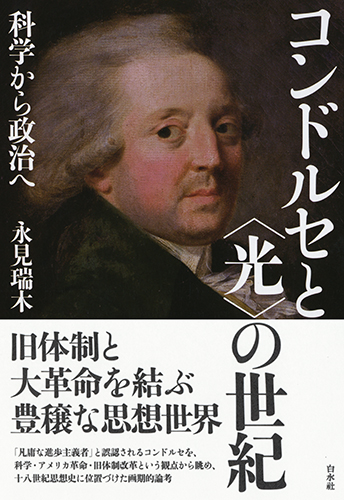
Title
Condorcet to hikari no seiki (Condorcet and the Century of Enlightenment: From Science to Politics)
Size
308 pages, 127x188mm
Language
Japanese
Released
January 26, 2018
ISBN
9784560095966
Published by
Hakusuisha
Book Info
See Book Availability at Library
Japanese Page
With the changes in the socio-economic and international environments of France in the second half of the 18th century, various problems became apparent in institutions that had sustained the class system until then. In such an era existed a man named Condorcet who played a variety of roles—mathematician, philosopher, politician. Thus far, Condorcet was known either as a leading advocate of public education and the idea of progress or as an unfortunate philosopher cut off from the future because of the revolution. In recent years, he has gained interest as a person involved in the birth of the social sciences. This book, however, focuses on Condorcet's vision of a political system for a new society and attempts to provide a complete picture from various perspectives, such as the tradition of political thought and the circumstances during that period.
First, Condorcet's academic background and the formation of his interest in integrated issues are discussed (Chapter 1). Starting out as a mathematician, Condorcet deepened his friendships with contemporary intellectuals such as D'Alembert, Voltaire, and Turgot, and, with his involvement in the reform of judicial system and royal administration, expanded his interest from the scientific world to the political realm. Though always conscious of human fallibility and the unreliability of society, he rejected excessively skeptical attitudes and looked to the probability theory to guide human judgments and actions in an uncertain world. Such a perspective involved uniting the intellect of a great number of individuals in society and linking it to an approach of gradually advancing reforms that incorporated revisions. Condorcet was also very inspired by the United States which, after gaining independence from the United Kingdom, was in the process of establishing a new state during the same period (Chapter 2).
Looking closely at the differences in the historical conditions and circumstances of the American and French societies, he proposed the theory of provincial assemblies as a plan of reform for the French monarchy. From these multiple local assemblies, he proposed the establishment of a hierarchical national assembly that would be based on the theory of equal representation and rejection of social discrimination (Chapter 3).
Times suddenly changed, and with the convention of the Estates-General, the era of the revolution began. Taking advantage of the previous concepts, the idea of a new Republic was presented through the draft constitution (Chapter 4). Its greatest characteristic was that it demonstrated a fluid system open to reconsideration and reexamination by incorporating voices of opposing citizens, and a structure that adopted institutional reform.
Condorcet lived over two hundred years ago, but the problems he faced and the questions he raised have never paled as the fundamental questions facing modern democracy, which provides much food for thought.
(Written by: NAGAMI Mizuki / September 03, 2020)



